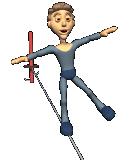Wednesday, June 29, 2011
..Raised in a circus, Huber tells story of a lifestyle that has faded..
By Justin Lacy
StarNews Correspondent
Published: Tuesday, June 28, 2011 at 8:55 a.m.
"Remember when you see us dressed as clowns, ours are human hearts beating with passion."
The phrase, taken from Ruggiero Leoncavallo's 1892 opera "Pagliacci," welcomes visitors to the Cameron Art Museum's "Fritzi Huber: A Circus Life," an exhibition of ephemera and art inspired by the Wilmington-based artist's unique upbringing.
"That sets the tone for the show," Huber said of the quote during a walkthrough of the exhibit in June. "Even though this is different from the lives that most of us experience, it is also a statement that everyone is the same."
Below Leoncavallo's words is a femme fatale clown Huber painted right onto the museum wall. Hanging upside down, the image is analogous to the hangman tarot card. For Huber, it is a sort of self-portrait signifying her stint as an aerialist as well as the changes in her life – her personal switch from trapeze artist to visual artist, as well as the broader decline of the once-prosperous circus industry, discernible through her family tree.
Huber was born into a multi-generational circus family. Her father, Fritz Huber, was a Swiss-born aerialist who ran away and joined the circus. Her mother, Barbara "Betty" Schutz, was an aerialist and acrobat from a long lineage of circus performers. Together, they were "The Sensational Kays" and toured America while raising Fritzi and her younger brother, Bobby, on the road.
"We had a home in New York and a home in Texas, but we only spent two or three months a year there," Huber said. "Most of the time, we were traveling, so home had to be within."
Huber was trained in aerial ballet as a child, but, as her parents wanted her to have an option outside of the circus, she didn't perform until the ‘70s, when she briefly returned to the family business. Huber chose to pursue the visual arts instead, feeling a strong affection for cast-papermaking.
"As a child growing up on the road," Huber said, "one of the things you always had to look for and be aware of was water. Where do you get it? How much is there? Does it come from a hose, or do you carry it in a bucket? What do you do with wastewater? Water became your crutches. So, the first time I made a sheet of paper and put my hands in that vat, that was a sort of (connection with) material that I had not ever experienced before with any other medium."
In her "Dressing Rooms" series, Huber makes paper from items found on her last circus tour in 1978, emphasizing the ephemeral quality of the transient circus lifestyle by creating ambiguous glimpses of absent performers.
"No one was in the dressing room," Huber said. "There were sequins laying on the floor, just scattered around. They were all packing up to leave, so I swept up the sequins and I saved my robe from that time. I ran around taking photographs of the dressing tables with everybody gone but everything still there – evidence of their presence."
Years later, Huber beat the robe into a pulp. She ground up the sequins, threw them into the pulp and formed paper. She then cut copies of the photographs sequentially and interwove them with the hand-cast paper, forming small gray quilts of vague nostalgia.
"The reason they're interwoven rather than giving you this literal image," Huber said, "is because memory isn't always clear."
Fascinated with documenting the past, Huber exhibits remnants of her circus life – memories preserved as costumes, scrapbooks, autograph books and traveling trunks. Her trapeze hangs from the ceiling. Across the room, a home video of her father performing is projected onto the wall. Her grandfather, Heinrich Schutz, is seen marching around the three rings of a nearly sold-out police relief show in the "golden age" of the circus. Nearby, there is a poster of her grandmother, Babette Brumback, better known as "Tyana, the World's Strongest Woman." She is depicted lifting an elephant by straps attached to her legs, a feat she would actually perform. (It was a small elephant).
Above the memorabilia is another quote, this one from the Yehuda Amichai poem "The Place Where We Are Right" – "And a whisper will be heard in the place where the ruined house once stood."
The poem is especially relevant for Huber. Along with her brother, who also left the circus business, she's the last in a long line of tradition.
"Everyone in this room, other than my brother, is not with us any longer," Huber said. "And what I'm feeling like is that I'm the whisper. I'm telling the story … When the tent has left, and there's nothing where the circus was, (my brother and I) would walk around and look for the hole in the ground where the stake was. We'd find the sequins on the floor, because that was the last remnants of the performances that occurred. Those sorts of things are really, really romantic for me."
Labels: circus
Subscribe to:
Post Comments (Atom)














1 comments:
The circus is a wonderful place...
Post a Comment